Authors
Graeme Dobell

Graeme Dobell, a journalist since 1971, has been reporting on Australian and international politics, foreign affairs and defence, and the Asia Pacific since 1975.
In 2013, he became Journalist Fellow with the Australian Strategic Policy Institute, writing for ASPI’s blog, The Strategist.
From 2008 to 2012, he was Journalist Fellow at the Lowy Institute for International Policy, filing The Canberra Column for The Interpreter blog.
Starting as a newspaper journalist in 1971 in Melbourne on The Herald, Graeme joined the Australian Broadcasting Corporation’s international service, Radio Australia, in 1975 and concentrated on politics and international affairs, serving as a correspondent in Canberra, Europe, America and throughout East Asia and the South Pacific.
Graeme was the ABC’s Southeast Asia correspondent, based in Singapore, and did several stints as the Canberra-based Foreign Affairs & Defence Correspondent for Radio Australia from 1978 to 2008, reporting also for ABC radio news and current affairs programs and ABC television. He worked as a journalist in the Parliamentary Press Gallery in Canberra in 1978-81, 1986-89 and 1991-2008.
In reporting on Asia, Graeme covered the security dialogue of the ASEAN Regional Forum, the East Asia Summit and a dozen APEC summits. Assignments in his career as a correspondent have included the Falklands War, coups in Fiji, Thailand and the Philippines, Beijing after the crushing of the pro-democracy movement in Tiananmen Square and the return of Hong Kong to China.
He is the author of the book Australia Finds Home — the Choices and Chances of an Asia Pacific Journey, published in 2000. In 2011, he was made a Fellow of the Australian Institute of International Affairs “for his distinguished contribution to journalism through his reporting on politics and international affairs.”
Articles by Graeme Dobell
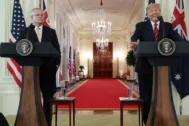
Australia-US/East Asia
October 2023 — November 2024Voters Consider, Trump Comes, China Coercion Cools
Australia’s politicians prepare for the national election that must be held by May. In judging the first term of Anthony Albanese’s Labor government, the key concern for Australia voters is the cost of living, while international issues are bracketed by the United States and China—the return of President Donald Trump and the cooling of China’s trade coercion of Australia. The Albanese government tells Australians they face “fraught and fragile global conditions” in a “a time of great global uncertainty,” in “the most complex and challenging strategic environment since the Second World War.” Canberra’s approach to the Trump administration will emphasize traditional alliance ties while reinforcing new elements: AUKUS nuclear submarines, the Quad, the increase of US forces on Australian soil, and steps toward free trade in defense equipment and technology to achieve more integration between US and Australian industries.
Australia’s Election, Trump’s US Election
One of the many unusual impacts of Trump’s return to the presidency is the influence he will have on the federal election Australia will hold by May 2025. Prime Minister Albanese choses the day, but the three-year federal election cycle means the latest date for the vote on the House of Representatives and half the Senate is May 17, 2025. The parliamentary sitting calendar for 2025 is shaped by the election deadline. Australia’s annual budget is usually presented to Parliament in May. But the date for the 2025 budget is brought forward to March 25, 2025. An early budget and then a May federal poll is the same timetable used by Scott Morrison’s Liberal-National Coalition government in the previous elections in 2019 and 2022.
Issues that resonated in the US election will echo in Australia—the cost of living, housing, and migration levels. The opposition leader Peter Dutton will mobilize an Australian version of the question Trump asked US voters: “Are you better off than you were three years ago?” Labor’s response will be to ask voters: “Who is going to make you better off in the next three years?”
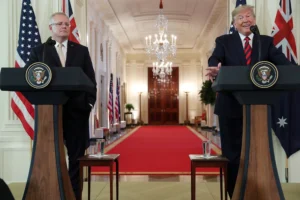
Figure 1 U.S. President Donald Trump speaks during a joint news conference with Australia’s Prime Minister Scott Morrison in the White House in Washington on September 20, 2019. Photo: Jonathan Ernst/Reuters
In the lower house of Parliament, where governments are formed, Labor goes to the voters holding the thinnest of majorities—78 seats in the 151-seat House of Representatives (redistributions will reduce the House to 150 seats at the election). The possibility of Labor being pushed into minority government looms as an equal or even stronger possibility than Labor hanging on to its majority. The Liberal-National Coalition holds 55 seats, while independents and minor parties hold 18. The Coalition will need a net gain of 20 seats from Labor and the cross-benches to return to office. The global electoral trend to punish incumbent government means the Albanese government has lost its lead in the opinion polls. Polls now deliver a near 50-50 split in the two-party vote for Labor and the Coalition; the polling margin of error decides which side is leading in individual polls.
The doyen of the Canberra press gallery, Michelle Grattan, observes that Trump’s victory in the United States will affect the climate of Australia’s campaign: “One obvious point of debate would be how either leader would potentially handle an unpredictable Trump. A Trump presidency might [favor] Opposition Leader Peter Dutton’s national security focus. But an opposite view, held in Labor circles, is it could make people stick to the status quo. Trump’s triumph would also be fodder for the Greens in their attack on Labor’s closeness to the US. For its part, Labor would argue the Australia-US alliance is enduring regardless of individual US and Australian leaders and governments.”
Finishing her term in Canberra, US Ambassador Caroline Kennedy emphasized what will be a key Australian talking point to Trump as she pointed to “the continuity that has characterized this alliance for more than a century.” Kennedy expressed the great alliance story Australia will seek to tell Trump: “Australia may be a middle power, but to the United States, you are number one. We have no more trusted or capable ally. In every dimension of our relationship, I’ve seen the United States rely on Australian leadership and experience. Australia is no longer America’s ‘deputy sheriff’ or whatever the critics like to say. Australia is our partner and often our teacher as the United States navigates a multipolar world. That’s true in our bilateral relationship. It’s true in multilateral fora, and it is vital in this region.”
After phoning Trump to congratulate him the day after the US election, Prime Minister Albanese said they “talked about the importance of the alliance, and the strength of the Australia-US relationship in security, AUKUS, trade and investment. I look forward to working together in the interests of both our countries.”
Albanese told a press conference: “President Trump has run a campaign based on change and he’s made it clear he’s going to do things differently–so we shouldn’t be surprised as things change. But equally, we should be really confident in ourselves and our place in the world as well, and our ability to deliver on our interests together as Australians.”
Albanese denied any need to apologize for previous negative comments on Trump’s first presidency. The most notable example was in 2017, when Albanese was an opposition frontbencher. Asked then how he would deal with Trump, Albanese answered “with trepidation,” going on to say “he scares the s–t out of me and I think it’s of concern the leader of the Free World thinks that you can conduct politics through 140 characters on Twitter overnight.”
Now as prime minister, Albanese says he will work with Trump, adding that he has demonstrated “my ability to work with world leaders and to develop relationships with them which are positive.” Australia’s ambassador in Washington, the former Labor prime minister, Kevin Rudd, acted swiftly after the US election to delete his previous criticisms of Trump. Media turned up plenty of examples of Rudd attacks, calling Trump, “the village idiot” and “the most destructive president in history.” A statement from the Australian embassy announced Rudd’s clean-up:
“In his previous role as the head of an independent US-based think tank [the Asia Society], Mr. Rudd was a regular commentator on American politics. Out of respect for the office of President of the United States, and following the election of President Trump, Ambassador Rudd has now removed these past commentaries from his personal website and social media channels. This has been done to eliminate the possibility of such comments being misconstrued as reflecting his positions as Ambassador and, by extension, the views of the Australian Government. Ambassador Rudd looks forward to working with President Trump and his team to continue strengthening the US-Australia alliance.”
Rudd’s previous criticisms were quoted in an interview with Trump in March by the British politician, Nigel Farage. In response, Trump responded by calling Australia’s ambassador “a little bit nasty,” and “not the brightest bulb.” While saying that the ambassador “won’t be there long,” Trump ended his response to the question about Rudd by noting, “I don’t know much about him.” After Trump’s election, the Albanese government expressed full confidence in Rudd and said he would stay as ambassador. Foreign Minister Penny Wong noted that Trump is “a pretty robust individual” while the alliance “is bigger than any individual or past comments. And in terms of Kevin, Kevin Rudd’s been an excellent Ambassador. He’s delivered an enormous amount for Australia, and I have great confidence that he’ll continue to do so.”
Australia will use the same lines that worked with Trump in his first term. The US has a trade surplus with Australia; or, in Trump-speak, America gets a good deal out of Australia. The balance of trade in America’s favor helped Australia avoid Trump tariffs on Australian steel and aluminum last time round. Australia’s talking points to Trump will highlight the transactional wins the US gets from the relationship. The bilateral free trade treaty with the US, the Australia-United States Free Trade Agreement reaches its 20th birthday in January 2025. The US is Australia’s top foreign investment destination, while the US is Australia’s top foreign investor, as Australia’s Foreign Affairs Department outlines:
“The United States is our largest two-way investment partner, with two-way investment stock reaching A$2.3 trillion in 2023. The United States is by far the largest investor in Australia, with investment stock worth A$1.17 trillion at the end of 2023. The United States is our largest foreign investment destination, with outbound investments reaching A$1.196 trillion in 2023. The United States is our third largest trading partner and two-way trade stood at $98.7 billion in 2023.”
Australia’s tactics for Trump 1.0 will run again for Trump 2.0. When Canberra finds it hard to embrace Trump’s language or agenda, the focus will switch to the greatness of the US, the depth of the bilateral relationship, and the history of military alliance. The alliance narrative during Trump 1.0 was the idea of “100 years of mateship,” dating from 1918 when troops from the two nations fought side by side at the Battle of Hamel on France’s Western Front. Elements of tradition and transaction will be used with Trump 2.0. The alliance tradition will be the long history of mateship, while the transaction will be the promised growth in defense spending to show Australia is no military free rider. The economic pitch will always start from a business bottom line—Australia’s trade deficit means America is in profit.
Canberra’s script will follow the line Foreign Minister Penny Wong used after Trump’s victory: “We have an alliance that’s based on our values, on our history and on our shared strategic objectives. It is a timeless alliance, and we look forward to working with him.”
The US Alliance
“The Biden administration advanced the most consequential and ambitious bilateral security agenda with Australia since World War II.”
US Ambassador to Australia Caroline Kennedy, Nov. 19, 2024
Allowing for normal diplomatic gloss, the ambassador reflects new dimensions in an alliance that is shifting, not merely evolving. Responding to big geopolitical trends, Joe Biden deepened and broadened the alliance and gave it a sharper Australian focus. In its eighth decade, the alliance is coming to Australian soil. The ANZUS history has been Australia joining America’s wars (Vietnam, Afghanistan, Iraq and “the war on terror”). Now the commitment is what America is doing in, with, and for Australia in:
- the AUKUS nuclear submarine agreement;
- the evolution of the Quad grouping of Australia, India, Japan, and the US;
- America’s step-up in the South Pacific, as Washington declared a “renewed partnership with the Pacific Islands,” responding to Australia’s view that China’s challenge creates “a state of permanent contest in the Pacific”;
- the build-up of US military muscle in Australian soil in a new era of alliance integration, with more US troops, planes, and ships in Australia:
- the creation of a US-Australia combined intelligence center in Canberra;
- prepositioning in Australia of US stores, munitions and fuel:
- the lifting of US restriction to reach toward free trade in defense equipment and technology, to achieve more integration of US and Australian industries.
Canberra’s National Defense Strategy, issued in April 2024, said that Australia “must work even more closely with the US, our closest ally and principal strategic partner.” The US is increasing investment in “infrastructure, capability and equipment” on Australian soil, while Australian policy is to strengthen military engagement with the US to:
- focus joint exercises and capability rotations with the US on collective deterrence and force posture cooperation;
- collaborate on defense innovation, science and technology;
- drive interoperability and interchangeability with US systems and capabilities;
- “leverage Australia’s strong partnership with Japan” in the trilateral relationship with the US;
- speed reforms to US “export controls, procurement policy and information sharing to deliver a more integrated industrial base.”
In the words of a Washington Post headline in August, “Australia offers US a vast new military launchpad in China conflict.” On a visit to Darwin, the chairman of the US House of Representatives Foreign Affairs Committee, Michael McCaul, said: “This provides a central base of operations from which to project power.” Building that base means the “biggest expansion of the US military presence in Australia since World War II,” according to James Curran, international editor of the Australian Financial Review and professor of modern history at Sydney University.

Figure 2 Australian Prime Minister Anthony Albanese, U.S. President Joe Biden, and British Prime Minister Rishi Sunak hold a press conference during the AUKUS summit on March 13 in San Diego, California. Photo: Leon Neal/Getty Images
Curran writes that the change in America’s approach since “the mid-1990s has been nothing short of staggering.” After the election of John Howard’s Liberal-National government in 1996, he notes, Canberra offered the Washington training facilities for US marines in northern Australia. The US declined. As the times have changed, so the US has altered its view of the military worth of Australia’s geography. See the official start point for that shift as November 2011, when President Barack Obama announced agreement for an annual marine rotation through Darwin.
The US presence or “posture” in Australia has had bipartisan political support. Noting that political consensus, James Curran questions how the US role in Australia is shifting the alliance foundation from deterrence to offense. “For Australia, the US alliance has always been the critical deterrent – any power considering hostile action towards Australia at least has to keep the existence of the ANZUS treaty in mind,” Curran writes. The central issue for Curran is whether Australia is being transformed “into a base for offensive US operations into Asia. Government language stresses deterrence rather than projection, but the debate is on as to where that line now blurs.”
The elements of the increased US use of Australia’s geography are known as the US Force Posture Initiatives, driven by a bilateral working group formed in 2021. Australia’s Defense Department calls the force posture work “a key component of the alliance” and a “tangible demonstration of the strength of the alliance.” The initiatives involve:
- Enhanced air cooperation “to deepen air-to-air integration that allows for seamless operation” and delivers security and stability across the Indo-Pacific region. Major air bases at Darwin and Tindal (near Katherine) in the Northern Territory are being upgraded. Tindal will be able to house up to six US B-52 bombers. Surveys are being done for upgrades to two air bases in Western Australia and one in northern Queensland. The US pledges to “continue frequent rotations of bombers, fighter aircraft, and maritime patrol and reconnaissance aircraft.”
- Prepositioning: the US is working on the requirements for long-term positioning of Army equipment material in Australia, plus the creation of a logistics support area in Queensland.
- Enhanced land cooperation involves “complex, integrated and combined” exercises and training with allies and partners in the region. The US Army provides capabilities and personnel, fuel infrastructure and explosive ordnance storage.
- During Exercise Talisman Sabre 2025, the US and Australia will test “new operating assumptions” in exercises “across the breadth of Australia.”
- The US supports Australia’s planned infrastructure upgrades at the Cocos (Keeling) Islands, an Australian territory in the Indian Ocean midway between Australia and Sri Lanka.
- Enhanced maritime cooperation to lift the logistics and sustainment capabilities of US surface and subsurface vessels in Australia.
- In Perth, in August, the USS Hawaii, a Virginia-class submarine undertook a maintenance package, the first time that a US nuclear-powered submarine has had maintenance performed outside the US or a US base, or had such work performed by non-US citizens. The Hawaii starts the process of creating a submarine rotational force operating from Western Australia, from the Stirling naval base in Perth. The aim as early as 2027 is to have five conventionally armed, nuclear-powered submarines rotating through Stirling—one sub from the UK and four from the US.
Prime Minister Albanese says work on critical minerals and clean energy has become “a third pillar” to the alliance, to stand alongside security and economic cooperation. The “compact” signed by Albanese and President Biden established climate and clean energy as “a central pillar of the Australia-United States alliance.” The work will deepen collaboration on the “critical minerals and materials that are vital to clean energy as well as defense supply chains.” Australian public opinion about the US is still warm, but trust declines. In the lead-up to the 2024 US presidential election, the annual Lowy Institute poll on how Australians view the world found levels of trust in the United States dropped five points from 2023 to 56%. This continues the fall since 2022, the second year of the Biden presidency, when Australian trust in the US stood at 65%. Using a “feelings thermometer,” Lowy asked Australians about “feelings toward” the US. While still warm, the 2024 measure fell four degrees to 59°, its lowest reading in the 20-year history of the Lowy poll, and down from an all-time high of 73° in 2015.
AUKUS
Australia’s quest for AUKUS nuclear-powered submarines is a thought bubble that turned into a huge project, driven by ambition and beset by anxiety. Canberra’s instant political consensus is a striking element of how quickly the bubble became policy. The Labor-Liberal unity ticket was set at the moment the AUKUS vision was announced by Australia, the United Kingdom, and the United States in September 2021.
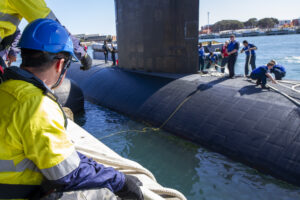
Figure 3 Navy Sailors assigned to the Los Angeles-class fast-attack submarine USS Annapolis (SSN-760) and HMAS Stirling Port Services crewmembers prepare the submarine to moor alongside Diamantina Pier at Fleet Base West in Rockingham, Western Australia, March 10, 2024. US Navy Photo
The distance covered in three years was emphasized by and Defense Minister Richard Marles when he told Parliament on Aug. 12: “When we came to power, AUKUS was really not much more than a thought bubble, but since then we have been turning it into a reality.” Marles says the thought is sailing along an “actual pathway,” steered by the Australian Submarine Agency, established last year. Some thought! Some bubble! Yet even the believers see an extraordinary journey—the Optimal Pathway, an outline plan for project execution, stretches out to 2053, with the first Australian-built AUKUS submarine due in “the early 2040s.” In August, a naval nuclear propulsion treaty was unveiled, providing the legal basis for AUKUS and the creation of an AUKUS trade zone for exchange of defense goods and technology. The treaty went to the Australian Parliament and US Congress in August and the UK Parliament in September. Marles signed the treaty in Washington on Aug. 5, describing it as “a foundational part of the legal underpinning” of building the nuclear-powered submarine.
The trilateral agreement will operate until 2075. The pact allows the transfer of nuclear propulsion plants to Australia, makes Australia responsible for “management, disposition, storage, and disposal of any spent nuclear fuel and radioactive waste” and gives an Australian indemnity to the US and Britain for any “liability, loss, costs, damage or injury” from nuclear risks. The treaty gives Britain and the US the right to terminate AUKUS and demand the return of nuclear material and equipment. The termination clause can be used if Australia seeks to reprocess nuclear material, builds a nuclear weapon, or breaches its obligations to the Non-Proliferation Treaty and the International Atomic Energy Agency. As part of its nonproliferation pledge, Australia is negotiating a treaty with the IAEA to meet its Article 14 comprehensive safeguards obligations.
In September, the three nations adopted an AUKUS zone for free trade of defense equipment and expertise. The exemptions remove licensing requirements for most controlled goods, technologies, and services. The AUKUS zone will have license-free trade for 70% of defense exports from the US to Australia that are subject to arms traffic regulations, and 80% of defense trade under US export regulations. The deal eliminates the need for 900 export permits covering Australian exports to the US and Britain, valued at $5 billion annually. Taking lessons from the AUKUS effort to cut red tape, the US has also set out principles to build an Indo-Pacific defense industry base.
Richard Marles says a license-free seamless defense industrial base for AUKUS will have “a profound impact,” describing it as one of the biggest reforms to defense trade in decades. In dealing with the new US administration from January, Canberra will push AUKUS as the top policy commitment it wants to reinforce with Trump. After Trump’s victory, Foreign Minister Penny Wong said “obviously we look to particularly prioritising AUKUS in our engagement, which is the thing that we have been most focussed on in the lead up to this election.”
Australia’s Strategy
Summing up foreign policy in a speech on Australia in the world, Albanese said Australia is investing in “deterrence and diplomacy,” transforming defense capability with the AUKUS pact, restoring relations in the South Pacific, revitalizing the Quad, taking a “patient, calibrated and deliberate approach” to China, and supporting the “fundamental guardrail” of US-China dialogue. In a stark view of strategic settings, Albanese and the deputy PM, Richard Marles, declared: “Australia faces the most complex and challenging strategic environment since the Second World War.” The Labor leaders offered that judgement on April 17, 2024, when releasing the National Defense Strategy. The strategy said: “While a major conflict is not inevitable, this new reality is making the pursuit of Australia’s interests more challenging.”
The strategy aims to double defense spending in the next 10 years to lift it from 2% to 2.4% of GDP by 2033-34. The increase in annual funding would see the defense budget grow to more than A$100 billion by 2033-34. The policy document described a strategic environment that continues to deteriorate:
“The optimism at the end of the Cold War has been replaced by the uncertainty and tensions of entrenched and increasing strategic competition between the US and China. This competition is being framed by an intense contest of narratives and values. The competition is playing out in military and non-military ways, including economic and diplomatic. It is accompanied by an unprecedented conventional and non-conventional military build-up in our region, taking place without strategic reassurance or transparency. The effects of this build-up are occurring closer to Australia than previously. This build-up is also increasing the risk of military escalation or miscalculation that could lead to a major conflict in the region.”
The Albanese government has scrapped the old “balanced force” model for the Australian Defense Force (ADF). The balanced force demanded lots of capabilities to keep options open. The balanced force could be adjusted to respond to whatever needs, contingencies, or dangers appeared on the horizon. An unbalanced future has arrived, and the balanced force is judged unfit for purpose. The ADF must become “an integrated, focused force” to face what Defense identifies as strategic risks that “have continued to deteriorate.” The new guidance to Defense from government is capitalized as “a Strategy of Denial,” calling for an ADF that can:
- defend Australia and our immediate region;
- deter through denial any adversary’s attempt to project power against Australia through our northern approaches;
- protect Australia’s economic connection to our region and the world;
- contribute with our partners to the collective security of the Indo-Pacific region;
- contribute to the maintenance of the global rules-based order.
A Strategy of Denial is appropriate for a nation that’s been through the stages of grieving for the disintegration of the liberal international order (denial, anger, bargaining, depression and acceptance).
Canberra proclaims it will take a “more focused approach to its international engagement.” The “focused” thinking can mean Australia is less willing to look beyond its region. Thus, in December, 2023, Canberra rejected Washington’s request to send an Australian Navy ship to the Red Sea as part of international efforts to safeguard cargo from attacks by Iranian-backed Houthi rebels. Richard Marles said Australia would not contribute a ship or plane to the Combined Maritime Forces that patrol the shipping route: “We need to be really clear around our strategic focus, and our strategic focus is our region—the northeast Indian Ocean, the South China Sea, the East China Sea, the Pacific.” The disappointed response from a US official was that Australia could not “pretend global problems don’t require global solutions.”
Australian responds to US-China competition as “a primary feature of our security environment,” a struggle over the global balance which will be “sharpest and most consequential in the Indo-Pacific.” The National Defense Strategy describes China’s expanding gray-zone activities and “coercive tactics” in its forceful handling of territorial disputes and unsafe intercepts of vessels and aircraft operating in international waters and airspace. China is improving its capabilities in all areas of warfare at a “pace and scale not seen in the world for nearly a century,” with no transparency about its strategic purpose, prompting this Canberra judgement: “The risk of a crisis or conflict in the Taiwan Strait is increasing, as well as at other flashpoints, including disputes in the South and East China Seas and on the border with India. There is increasing competition for access and influence across the Indian Ocean, including efforts to secure dominance over sea lanes and strategic ports. That said, US-China dialogue, both at the leader-level and military-level, is useful in preventing miscalculation and ensuring differences can be worked through in a way that supports stability.”
China: Seeking Balance as Economic Coercion Cools
“China does not see itself as a status quo power. It seeks a region and a world that is much more accommodating of its ambitions and its interests.”
Prime Minister Albanese, Dec. 20, 2023
“Over the past decade, we have made some progress in China-Australia relations and also witnessed some twists and turns. That trajectory has many inspirations to offer. Now, our relations have realised a turnaround and continues to grow, bringing tangible benefits to our two peoples.”
President Xi Jinping, Nov. 18, 2024.
Australia’s understanding of China’s future strategic pressure is shaped by Beijing’s recent unsuccessful, but costly, economic coercion. China’s trade sanctions on Australia have been wound back. Beijing’s refusal to talk to Australian leaders has ended. A relatively conventional diplomatic rhythm has resumed. Labor came to office in 2022 saying it would “stabilize” dealings with China, and stability has been achieved. China has scrapped its tariffs and unofficial customs bans on coal, barley, beef, wine, timber, lobsters, and cotton. Australia’s Trade Minister, Don Farrell, says nearly A$20 billion worth of “trade impediments on Australian exports to China have been removed.”
While defrosting with Beijing, the Albanese government kept getting warmer with Washington. The symbolic expression of this was in the prime minister’s back-to-back visits to the US and China. First, Albanese went to Washington at the end of October 2023. Then, a week later, he was in Beijing, the first visit by an Australian leader in seven years.
In Washington, Biden and Albanese proclaimed a new era of strategic cooperation to build what Albanese calls “an alliance for the future.”
As Australian journalists and TV crews gathered in the Oval office to record the grip-and-grin between Biden and Albanese, the president offered the Australians some unprompted remarks about the dragon in the room. “I was asked by Xi Jinping a couple of years ago why I was working so hard with your country,” Biden noted. “I said. ‘we’re a Pacific nation.’ He looked at me and I said, ‘Yeah, we’re a Pacific nation, the United States, and we’re going to stay that way’.”
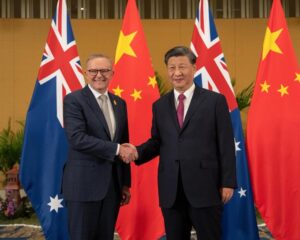
Figure 4 Anthony Albanese meets Xi Jinping in Beijing. Photo: Australian Strategic Policy Institute
China welcomed Albanese in November 2023, seeking to cement the reset in relations, blaming past troubles on Australia’s previous Liberal-National government. The official China Daily described the trip as “ice-breaking” after dialogue halted in 2016 “because of the previous Australian government’s adversarial stance toward China.” Part of the thaw has been an end to China’s ban on Australian journalists. In August, 2024, Will Glasgow, a correspondent for Rupert Murdoch’s paper, The Australian, returned to China, almost exactly four years since Australian correspondents fled the country. Glasgow wrote: “The beginning of the return of Australian media is another manifestation of the improvement in diplomatic relations with China under the Albanese government, which continues despite a host of ongoing disagreements…It is by no means an exclusively Australian problem. The size of the English-language foreign-media presence here is a fraction of what it was when I was based in Beijing for The Australian in the first half of 2020.”
One of the continuing disagreements is China’s suspended death sentence on the Australian citizen, Dr Yang Jun. The sentence was denounced by Foreign Minister Wong in February, saying Australia was “appalled” at the “harrowing news” The “many years of uncertainty” since Yang’s detention on national security charges in 2019 were “extraordinarily difficult,” Wong said, and Australia would protest “in the strongest terms.” In November, Wong attacked the sentencing of Australian citizen Gordon Ng in Hong Kong “for organising and participating in an election primary.” Wong said Australia is gravely concerned at China’s broad application of the national security law and its use against Australian citizens
In Australia, public sentiment toward China remains low. The Lowy Institute survey of Australian attitudes to the world found only 17% of Australians say they trust China “somewhat” or “a great deal” to act responsibly in the world (only Russia ranks lower in Australian opinion). This is steady from 2023 and a minor increase on 2022, when trust in China reached a record low (12%). The low numbers are a contrast with the figure just six years ago, when half (52%) of Australians trusted China. The suspicion of China reflects the icy years of trade coercion, and publicity about Chinese cyber-attacks on Australia.
Australia’s chief spy-catcher, Mike Burgess, acknowledges that all nations spy, but charges that China’s “behavior goes well beyond traditional espionage.” The director-general of security says: “The Chinese government is engaged in the most sustained, scaled and sophisticated theft of intellectual property and expertise in history. It is unprecedented and it is unacceptable. China has developed a ruthless business model to seize commercial advantage. Stealing intellectual property is the first step. Then they use talent programs, joint ventures and acquisitions to harvest the expertise required to exploit the intellectual property. Sometimes the technology is put to military use, often it’s given to favoured companies to mass produce it, under-cutting and undermining the innovator.”
Australia in Comparative Connections: 2009-2024
The first annual account of Australia’s connections with the US and East Asia appeared in this series in 2009. Thus, this year’s report is the 16th in the series I have written. My initial chat with the doyen of Pacific Forum, Ralph Cossa, set the scene for the warmest partnership any journalist could ask for. How long should my annual piece be? “Whatever it needs,” replied Ralph. Subject range, I asked? “Over to you,” responded Ralph. And so it has gone, ever since. Apart from Americanizing my spelling, the words have all be mine. Would that all editors were so generous of spirit, liberal about length, and open on content.
Looking back, that first 2009 effort offered two big themes that have endured. One pole was the continuity and comfort of the alliance fundamentals between Australia and the US. The other pole was the “tectonic effects being exerted by China’s rise. As with the rest of the Asia-Pacific, Australia is adjusting significant aspects of its foreign and security policy to the magnetic pull of China.” Official Australian usage is now “Indo-Pacific” not “Asia-Pacific.” But much else has endured, as one other line from that first effort observed: “For the first time in Australia’s history, its most important market is not also an alliance partner. Instead, it will be its major ally’s strategic competitor, perhaps even challenger.”
The 2011 report observed that Australia had decoupled from the US economy in ways unimaginable in the 20th century. In the first decade of the 21st century Australia did not follow the US into recession in 2001 and 2008. Asia’s business cycle now drives Australia’s economy: “Australia’s alliance commitment with the US no longer mirrors, as it once did, the economic ties to the US.” This annual series traced the 12-nation negotiations for the Trans-Pacific Partnership, launched in 2008, as the talks (and arm wrestling and haggling) crawled toward an ever-shifting finish line. In the arcane world of trade negotiators, the battle between the US and Japan was trench warfare lit by pyrotechnics. As Barack Obama observed, the TPP was an ambitious US effort to write the future trade rules of the Asia-Pacific, reflecting American interests in areas such as intellectual property rights, and labor and environmental standards.
The TPP was signed but then Australia watched in horror as the 2016 US presidential campaign trashed the agreement.” In the Australian interpretation,” I wrote in 2016, “a US that turns away from the TPP would also be turning away from Asia.” In his first week in office in 2017, Trump signed an executive order formally withdrawing the US from the TPP. Yet Washington commentary noted this was mere formality, because the treaty was already dead in Congress. My 2017 comment: “Can you create an enhanced trade structure to buttress the US strategic role in the Asia-Pacific if the US opts out of that trade pact?” A US turning protectionist is going to stress test the link between security and trade.
To end this round up of commentary/judgements, turn to the professionals in the game—the ambassadors (one Australian and two Americans) and an academic.
When an Australian jumps out of a New York taxi and prepares to make a dash across 5th Avenue, the habit of a lifetime is to look the wrong way for the traffic. Australia drives on the left; America drives on the right. It’s a simple metaphor for the many ways of looking and moving of the two nations. Rushing for a late-night drink in the city that never sleeps, Australia’s ambassador to the US, Joe Hockey (2016-2020), stopped his taxi by Central Park and dashed across the avenue, checking in the Australian direction. That “near-fatal error,” Hockey observed in his memoir, was “like so many who think they understand America.”
In 2010, the US and Australia marked the 70th anniversary of their formal diplomatic relationship. US Ambassador to Canberra, Jeffrey Bleich (2009-2013) said the relationship existed long before the 1940 treaty and extended far beyond words on paper: “Before there were diplomats in each other’s capitals, there were world-travelling whalers and miners, sailors of the Great White Fleet and their gracious Australian hosts, yanks and diggers hunkered down in trenches in World War I. We’ve trusted each other… We’ve valued each other’s freedom, self-reliance, open markets and sense of fair play. We’ve taken our work seriously, without taking ourselves too seriously. And when we’ve disagreed, we’ve done it without being disagreeable.”
During the 2013 Australian election, the American intellectual Francis Fukuyama visited and judged that the bitterness of Australian politics has not reached the intensity of the US: “Australia has got the fewest big long-term problems of any developed democracy I know. In policy terms, the fight within Labor, or even between Labor and the Liberals seem minor when compared to the things that [polarize] Americans, such as the legitimacy of taxation, dealing with the deficit, abortion and guns.”
Wrapping up her time in Canberra, the 27th US ambassador to Australia, Caroline Kennedy, used a farewell at the National Press Club in November to sketch what Australia means to her: “I will miss the Australian sense of humor and the fact that everyone has a nickname. I will miss the way Australians are up for anything and pitch in to help each other out. I will miss the amazing creatures here, from the magpies and whale sharks to my two new embassy sheep, Louie and Eli. I can’t wait to come back and visit. There is so much left to see and do. Most of all, I know the best days for our alliance are yet to come.”
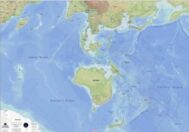
Australia has peeled back China trade coercion as it ramps-up the alliance with the United States to balance China. The Labor government, elected in May 2022, claims a diplomatic thaw with China as a key achievement. The major defense step was agreeing for Australia to get nuclear submarines under the AUKUS agreement with Britain and the United States. The government’s 2023 National Defense Statement describes “an intense contest of values” in the Indo-Pacific, with growing “risks of military escalation or miscalculation.” Because of the worsening strategic environment, the Australian Defense Force is judged “not fully fit for purpose” as the government seeks greater long-range strike capability. The era of alliance integration will see more US troops, planes, and ships in Australia, and the creation of a US-Australia combined intelligence center in Canberra. The contest with China in the South Pacific frames a new Australian aid policy and a greater US role in the islands.

Australia-US/East Asia
September 2021 — August 2022Australia’s New Government: Climate, China and AUKUS
Australia has changed government and the political war over climate change draws to a close after raging for 15 years. The new Labor government led by Anthony Albanese promises continuity on foreign and defense policy, delivered with a different tone. In the government’s first 100 days, it chipped some ice from the frosty relationship with China. Ending a Beijing ban on meetings with Australian ministers that was in its third year, Chinese ministers had face-to-face talks with Australia’s foreign minister and defense minister. Albanese’s observation that dealing with China will continue to be difficult was demonstrated by a diplomatic duel in the South Pacific, as Canberra pushed back at Beijing’s ambition for a greater security role in islands. Two major defense announcements are due in the first months of 2023: the plan for an Australian nuclear submarine, based on the AUKUS agreement with the US and UK, plus a re-set of Australia’s military and strategic posture because of the toughest security environment in decades. Labor says the alliance with the US should go “beyond interoperability to interchangeability” so the two militaries can “operate seamlessly together at speed.”
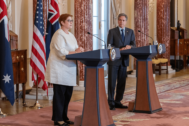
Australia-US/East Asia
September 2020 — August 2021COVID and China Chill, Alliance Anniversary and Afghanistan
Australia closed its borders to confront COVID-19 and rode out recession, while China shut off key markets to punish Australia. The short recession caused by pandemic ended Australia’s record run of nearly three decades of continuous economic growth; Beijing’s coercion crunched the optimism of three decades of economic enmeshment. However, Australia’s economy rebounded while the China crunch continues, causing Australia to question its status as the most China-dependent economy in the developed world. The Canberra-Beijing iciness has built over five years, marking the lowest period since the establishment of diplomatic relations in 1972. In 2021, the language of “strategic partnership” died and the “strategic economic dialogue” was suspended by China. The Biden administration promised not to abandon Australia, saying that US-China relations would not improve while an ally faced coercion. Australia embraced Washington’s assurance, along with the elevation of the Quad with the US, Japan, and India.
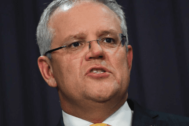
Australia-US/East Asia
September 2019 — August 2020Coronavirus, China and the US New Normal
Challenged by COVID-19 and China, Australia confronts deteriorating strategic prospects and its first economic recession in nearly 30 years. The pandemic has worsened strained relations between Australia and China. Canberra’s call for an inquiry into the origins of COVID-19 was attacked by Beijing as a betrayal and Chinese trade retaliation has followed. Even before the pandemic hit, Australia talked of a “new normal” with China of “enduring differences.” Whatever the US election result, the phrase “new normal” is also being applied to changes wrought by President Trump. The US alliance is hugged anew as Canberra abandons a central strategic tenet held for 50 years—the idea that Australia would have 10 years warning of any direct military threat.
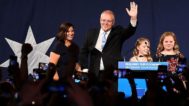
Australia-US/East Asia
September 2018 — August 2019Scott Morrison, Donald Trump, and the Indo-Pacific
Echoing uncertain geopolitical times, Australian politics confounded opinion polls and pundits at the May 18 federal election. Re-election of the Liberal-National coalition government was a “miracle” result, according to Prime Minister Scott Morrison. The surprise victory transformed Morrison’s authority within his party and the country – and burnished his relationship with US President Donald Trump. Morrison says the shift in the US-China relationship from engagement to competition is “inevitable,” calling for the Indo-Pacific to deepen patterns of cooperation so the competition does not become adversarial. Australia was an early adopter of the Indo-Pacific concept, describing it as a useful geographic construct. Now Australia is embracing the Indo-Pacific not merely as construct, but as a US strategy – the Free and Open Indo-Pacific.
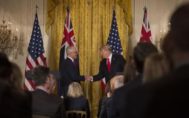
Australia-US/East Asia
September 2017 — August 2018Turnbull Tumbles, Trump Mateship, China Frost
In a week of political mayhem, Australia’s ruling Liberal Party dumped its leader, Prime Minister Malcolm Turnbull, and shunned its deputy leader, Foreign Minister Julie Bishop. While the political unrest is deeply domestic in nature, it shares one element with Australian’s foreign policy concerns – uncertainty. The Australia-US relationship under Donald Trump has been defined by what the president has NOT done to Australia. Trump hasn’t questioned the alliance; hasn’t hit Australia with trade tirades and tariffs; hasn’t broken the refugee deal he so denounced when first taking office; and hasn’t even sent an ambassador to Australia. Canberra’s softly-softly approach to Trump is to talk up the military history – “100 years of mateship” – stressing Australia is an alliance partner that doesn’t cost the US much. A major talking-point is that Australia has a trade deficit with the US. In the way that Trump defines trade relationships, the US makes a profit out of Australia. In contrast, the relationship with China has gone through an icy patch.
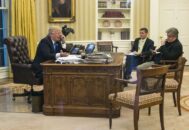
Australia-US/East Asia
May — August 2017The Donald Dichotomy: US Leadership Without the Leader
The uncertainty generated by President Donald Trump has made Australia cling ever tighter to the US alliance. The Trump effect hit Canberra within days of Trump taking office. The phrase “shock and awe” springs to mind – rendered in the alliance realm as “shake and appall.” The first phone conversation between Trump and Prime Minister Malcolm Turnbull was a version of “shake, rattle and roll.” Canberra wants to play nice with The Donald, and say nothing publicly that is critical of the president. The template for the Australian approach was on display early when the president withdrew the US from the Trans-Pacific Partnership. The Turnbull government expressed great regret at the decision but said nothing about the man who’d made it. While striving not to affront the president, Australia’s language about China has become shriller. Tongue-tied by Trump, Canberra gives stronger voice to concerns about China. Turnbull has referred to the “dark view” of a “coercive China” seeking Asia domination. Stern words about China’s threat to the rules-based system serve a dual purpose: speak to Beijing about the value of the system while implicitly pleading with the US not to abandon what it has built and policed – and mightily profited from.
Australia-US/East Asia
September — August 2016Turnbull, TPP, and Trump
While Malcolm Turnbull’s coalition government was narrowly returned to office in Australia’s 2016 election, Australia’s thinking about Asia’s future hinges on another election. Concern about the US presidential race has joined worries about Asia’s “rules-based order” and growing competition between the US and China. Not least of Australia’s fears is what US politics will do to the Trans-Pacific Partnership trade deal. Meanwhile, there were a few “surprises” between Australia, the US, and Japan that shaped relations over the summer months and will likely continue to influence them in the coming year.
Australia-US/East Asia
September 2014 — August 2015Alliance, Trade, Climate, and China
The Obama administration and the Abbott government stood together in the new military coalition in Iraq and joined in the trade push for a Trans-Pacific Partnership. Australia’s Defence White Paper, about to be released, will be a strong and detailed statement of support for the alliance with the US. Yet, the discussion of the US-Australia relationship often turned into a debate about China. The notable political difference between Obama and Abbott in the past 12 months was over climate change. The US president highlighted the policy difference in a speech during the G20 Summit that Abbott hosted in Brisbane. The other divergence between Australia and the US was over China’s creation of the Asian Infrastructure Investment Bank. After initially sharing US fears about the bank, the Abbott government eventually decided to abandon the US and Japan and became a founding member.